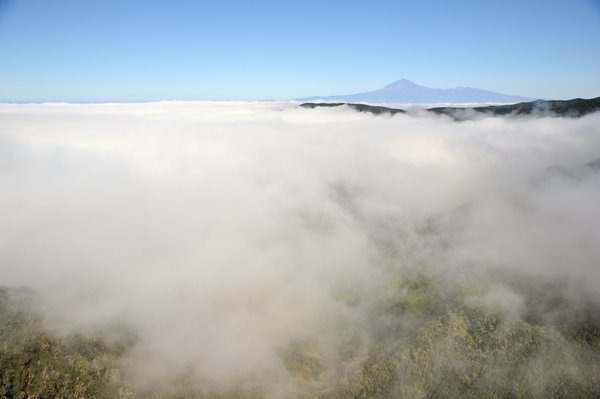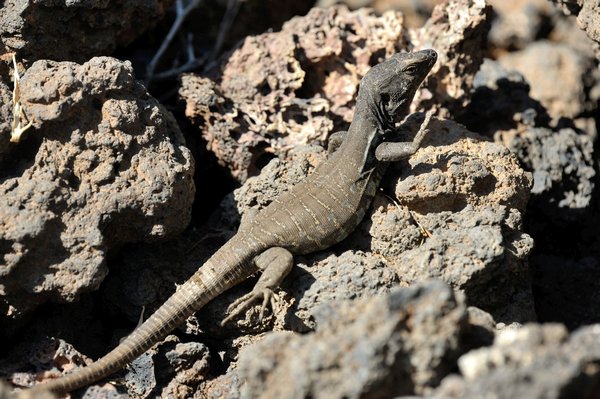Now for the second part of our trip -- Tenerife and La Gomera!
One thing in advance for people interested in biology: There is a Canary-/canariensis of everything! Sooooo many endemic* species! Pick any random genus you like and you will have an endemic for sure: liverworts, random other plants, birds, spiders, snails, grasshoppers... And even more ex-beings, because the influence of the humans likely resulted in eradication of numerous species. Ah yes, I didn't forget, and reptiles of course! Namely (besides some geckos and skinks) lizards of the genus Gallotia, the different Canary lizards, which only exist there, some of them even only on one island.
*endemic means, that a species/genus occurs only in a single geographic region, for example an island or mountain range. So animals of an endemic species of the Canary Islands exist only on the Canary Islands and nowhere else in the world.
So what shall I say, countless endemic (sub-)species -- biologist's heart, what more do you want? Ah, btw., the app iNaturalist turned out to be very useful, we got plenty of help from the community in determining taxa; from liverwort over grasshopper to skeletonized puffins and more :-D
Back to the trip: after visiting southern Spain we were flying directly from Malaga to Tenerife North, rented a car (from Cicar car rental, recommended, because you can change islands with the same car), went shortly to the northern parts of the island for a coffee and cake at
Cafe Melita (with amaaazing view to the sea and the surfers, such a nice place to be and relax for some hours) and then continued, still on the same day, via ferry to La Gomera.
La Gomera is a beautiful island, with still a comparatively small amount of tourists and has only one downside: there are not many straight meters of street on that island. Things to do there? Going hiking in wonderful landscapes, watching lizards, enjoying the richness of nature and just relax. One of the two lacertid species there is very common: Gallotia caesaris gomerae (Kleine Kanareneidechse / Boettger's lizard). Here a typical coloured female:
Below left a male of the same species (Gallotia caesaris gomerae), and on the right the skink Chalcides coeruleopunctatus (Südlicher Kanarenskink, La Gomera Skink), which is found only on El Hierro and La Gomera.
And another male of Gallotia caesaris gomerae. They were actually more shy than I expected, which was the reason I needed to use the 300mm/4.0 lens, resulting in poorer image quality than with the macro lens.
Conerning the second, and very rare (likely one of the rarest on earth), lizard species on La Gomera, Gallotia bravoana: we didn't even try to find it. It only occurs in a very small, difficult to walk in area, so not a good goal for a honeymoon :-P There would be a breeding station, but you don't find any possibility to contact them, except for a post adress in a herpetological field guide (which we found out too late). So with more effort we would have maybe seen it, but we decided to spend the time otherwise.
...landscapes! Like always, I was too lazy to change lenses, so there are only few landscape pictures. Left: the view from the tree heath/lorel forests towards Tenerife and the Teide volcano. The clouds are the typical trade wind/passat clouds that make the laurel forests possible. Right: random evening view on La Gomera.
Also an interesting experience, being of volcanic origin, the sand on (some?) beaches of La Gomera is black.
Another cool thing existing on La Gomera is the whistling language "El silbo", one of the most developed whistling languages on earth -- you can really "talk" with it and it's taught on schools! The first time I heard it, I was wondering which weird type of bird is calling like that...
After some 5 or 6 days of hiking on La Gomera we went back by ferry to Tenerife. It's approximately one hour of ride, and everything, including taking the rental car, went smoothly. On Tenerife we were situated in the Casa Rural Arona, a wonderful place where you get an amazing and extensive, freshly prepared vegetarian or vegan breakfast every morning.
Tenerife is the biggest of the Canary Islands, and a main part of it is the volcano Teide -- with 3.715 m the actually highest mountain of "Spain". Funfact: geologists think, that it might have been even over 7.000 m, before the top of the volcano broke off and slid into the sea.
The diversity of volcanic landscapes is amazing, and there are also several smaller extinct volcanoes to visit on the island. So we were also mainly hiking. My personal goals on Tenerife were: clicking and feeding lizards and finding Gallotia intermedia, one of the rare "giant" lizard species of the Canaries. And we luckily succeeded with both 🥳
Photographing the on Tenerife very common Gallotia galloti (Tenerife Lizard, Westkanaren Eidechse) is luckily easy, meaning I could use my 180mm/2.8 macro lens without problems. These lizards are not shy, and can, with a bit of patience, even be fed with fruits or bread, especially in regions with many tourists. The north of Tenerife is inhabited by the more colourful subspecies Gallotia galloti eisentrauti. We were, at least I think so, just before the mating season, so the males were not in full bright mating colouration.
Anyhow, they are still very pretty animals, the top two pictures are males of Gallotia galloti eisentrauti, the bottom picture a is female of the same subspecies, all from the very north of Tenerife.
Regarding the plants, there are soo many different things to see. Two of the species which especially catch your eye in the drier southern parts of Tenerife are Euphorbia canariensis (Kanaren-Wolfsmilch, Canary Island spurge) and Lavandula sp. (lavander, Lavendel). Of the latter there are 3 Canary-endemics on Tenerife (one of them being a canariensis, how else could it be :-P). Stupid me realised too late, that there are three species, so I couldn't determine them. The Euphorbia canariensis are huuuge, several meter high plants and an imposing appearance (upper picture). And the lavander gave you an impression of spring in the otherwise arid landscape (lower three pictures).
In those drier central and southern parts of Tenerife, you can find the second subspecies Gallotia galloti galloti more or less everywhere, in changing abundancies. It is less colourful than the subspecies of the northern parts, eisentrauti, but still always a pleasure to click. Top left: a female, the rest are males.
One of our last hikes went on a short tour to the plateau of Teide at approx. 2.200 m.a.s.l. around the Roques de García. Volcanic landscapes and frozen lava fields whereever you look. because of much dust in the air, short before twilight it looked like on another planet. Top left: view to the top of Teide (which we didn't reach, because you need to buy a ticket for the lift several days in advance, and reaching the top requires booking for it even several months before). Top right: a part of the Roques de García. Bottom: Sunset seen from the Roques de García, like views from another planet...
Besides being a hiking paradise, the Canary Islands provide perfect conditions for (kite) surfing. Two or three times we were just sitting with ice cream or in a café and watching them having fun. It's really impressive what they are doing, some of the kite surfers even performing acrobatic moves hiiigh above the water (on the following picture is a just little, below average jump ^^).
Like quite often on (field) trips, the main highlight happens on the last day. I mentioned that I also wanted to see Gallotia intermedia (Tenerife Speckled Lizard, Gesprenkelte Kanareneidechse), one of the very rare "giant" lizards of the canary islands. It is found only on two (maybe three) places on Tenerife, is therefore one of the rarest lizards on earth, and I really wanted to see it. So we devoted a full day just for finding and photographing one.
Well, after hours of searching without results (only Gallotia galloti), being exhausted from heat and running around in hard terrain, I was already giving up. But then my better half saved the day twice. First she directed me to the place where they were actually sitting ("But we didn't look in that corner over there"). There I only saw something which couuuuld have been a larger grey something, but just slipping down from a stone in the corner of my eye. So I waited there for 20 minutes that it shows up again - in vain. Again I gave up and was about to head back to the car (in very bad mood) when my wife saved the day a second time, calling me with "there is a big lizard here, could that be one?". Well -- it wasn't, it was "just" a pretty big specimen of Gallotia galloti, but 2 meters behind it, there was suddenly basking the so much wanted Gallotia intermedia!! I felt such relieve! And in the end we found 3,5 of them, all within maybe 100 or 200 meters (0,5 counting the grey something from before).
So here they are, pictures of Gallotia intermedia (Tenerife Speckled Lizard, Gesprenkelte Kanareneidechse), my personal biological highlight of the trip!
So to sum this southern Spain/Canaries honeymoon trip up: it was an amazing combination of culture, hiking, nature observation and a bit of herping too (with eventually great results 🥳 )!
...we just maybe should have taken more than one resting/relaxing day in three weeks :-D
Ah, the obligatory music reference in the end: I have to repeat that I'm still amazed by the Jezabels' album Synthia, especially
Stand and Deliver,
Unnatural and
Stamina.























